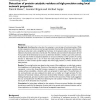Free Online Productivity Tools
i2Speak
i2Symbol
i2OCR
iTex2Img
iWeb2Print
iWeb2Shot
i2Type
iPdf2Split
iPdf2Merge
i2Bopomofo
i2Arabic
i2Style
i2Image
i2PDF
iLatex2Rtf
Sci2ools
BMCBI
2008
2008
Detection of protein catalytic residues at high precision using local network properties
Background: Identifying the active site of an enzyme is a crucial step in functional studies. While protein sequences and structures can be experimentally characterized, determining which residues build up an active site is not a straightforward process. In the present study a new method for the detection of protein active sites is introduced. This method uses local network descriptors derived from protein three-dimensional structures to determine whether a residue is part of an active site. It thus does not involve any sequence alignment or structure similarity to other proteins. A scoring function is elaborated over a set of more than 220 proteins having different structures and functions, in order to detect protein catalytic sites with a high precision, i.e. with a minimal rate of false positives. Results: The scoring function was based on the counts of first-neighbours on side-chain contacts, third-neighbours and residue type. Precision of the detection using this function was 28....
Active Site | BMCBI 2008 | Protein | Scoring Function |
| Added | 09 Dec 2010 |
| Updated | 09 Dec 2010 |
| Type | Journal |
| Year | 2008 |
| Where | BMCBI |
| Authors | Patrick Slama, Ioannis Filippis, Michael Lappe |
Comments (0)

